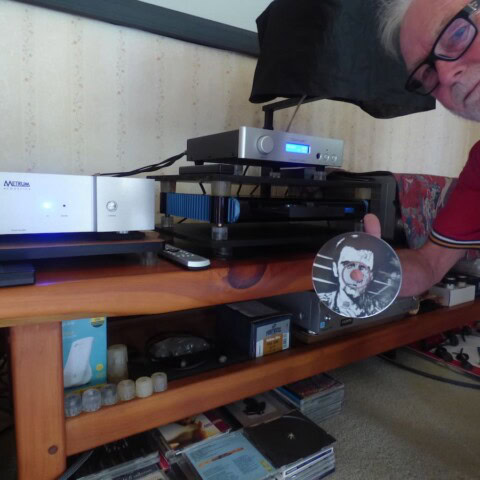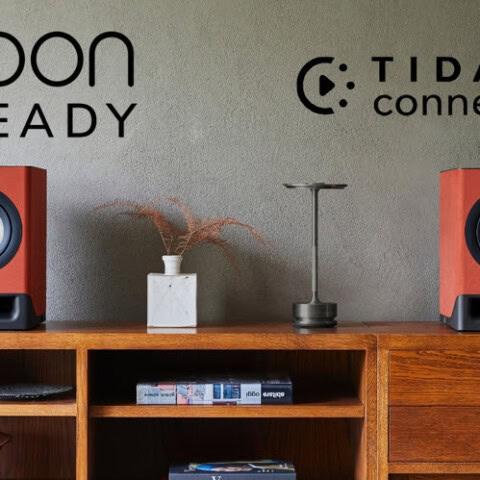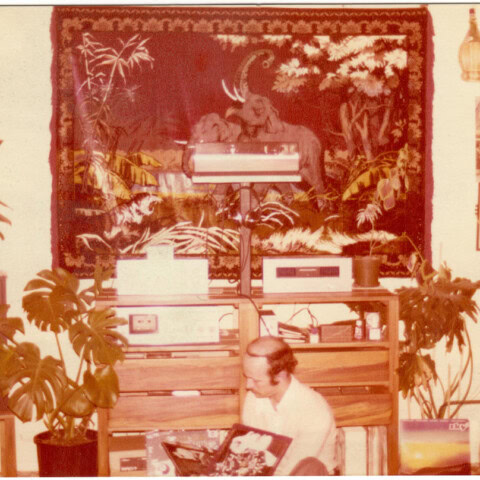Summary
JAVA Hi-Fi Double Shot Power Amplifier
Innovative technology, luxury build, beaut design aesthetic and superb musical performance combine on this Kiwi amp writes ANDY BAKER.
$11,495

 When it comes to driving my loudspeakers, integrated amplification has generally been my cup of tea (or coffee, as it were), with convenience and budget largely being the main deciding factors. These days there are some fantastic integrated amplifiers on offer – some being so well-furnished you don’t even need a separate DAC, phonostage or even streamer because it’s all there in one box. Yet some terrific pre- and power amp combos have passed through Baker Studios over the years – Perreaux, Plinius and Conrad Johnson to name a few – and now my rack has been graced with the presence of a lovely pair of JAVA separates.
When it comes to driving my loudspeakers, integrated amplification has generally been my cup of tea (or coffee, as it were), with convenience and budget largely being the main deciding factors. These days there are some fantastic integrated amplifiers on offer – some being so well-furnished you don’t even need a separate DAC, phonostage or even streamer because it’s all there in one box. Yet some terrific pre- and power amp combos have passed through Baker Studios over the years – Perreaux, Plinius and Conrad Johnson to name a few – and now my rack has been graced with the presence of a lovely pair of JAVA separates.
JAVA Hi-Fi is a New Zealand company situated in a lovely location on Auckland City’s North Shore. Last year I reviewed the fantastic Single Shot integrated, and it easily became one of my favourite amplifiers. JAVA use GaN FET (GaN = Gallium Nitride) transistors along with LDRs (Light Dependent Resistors) in their circuitry, and claims to be the first in the world to do so. You can read more about this in my Single Shot review but, in a nutshell, JAVA use GaN FET technology instead of the usual silicon-based transistors and these form the basis of the switch-mode power supply. These switch at high speed, giving little to no distortion and generating very little heat. GaN FETs are Class D, but not as we previously knew it.
 While this review is ostensibly all about the Double Shot power amp, CEO Martin Bell also lent me one of his LDR pre-amplifiers. This meant that while I don’t currently have another power amp on hand to make comparisons, I could at least utilise the excellent pre-amp section of my Electrocompaniet ECD 2 DA Convertor to really help get an idea of the Double Shot’s sound signature.
While this review is ostensibly all about the Double Shot power amp, CEO Martin Bell also lent me one of his LDR pre-amplifiers. This meant that while I don’t currently have another power amp on hand to make comparisons, I could at least utilise the excellent pre-amp section of my Electrocompaniet ECD 2 DA Convertor to really help get an idea of the Double Shot’s sound signature.
Build and Features
The Double Shot shares the aesthetics of its fellow JAVA stable mates – the CNC-machined top and bottom real wood casework (and real wood veneers) curving gracefully over the sides of the chassis, an 8mm anodised aluminium front panel and the large side-mounted heatsinks. The front panel of the Double Shot consists of the JAVA logo in the centre and a large circular, LED-illuminated touch panel for bringing the amp in and out of standby mode – just the lightest of touches turns it on or off and I believe the sensitivity can be adjusted. (A couple of times I came into the room to discover the amp mysteriously turned off, events I’m convinced were due entirely to my awesome cat brushing past the front – he likes to check out new additions to the music room).
 Around the back can be found both balanced and single-ended pre-amp inputs with an accompanying balanced/SE switch, beautifully crafted ETI Research speaker binding posts, power input socket and the main power on/off switch. Internally, the PCB assembly is inverted to help control vibration and resonance.
Around the back can be found both balanced and single-ended pre-amp inputs with an accompanying balanced/SE switch, beautifully crafted ETI Research speaker binding posts, power input socket and the main power on/off switch. Internally, the PCB assembly is inverted to help control vibration and resonance.
The Double Shot gives a hefty 400 watts into 8 Ohms per channel, or 800 watts into 4 Ohms per channel. The demo unit came in an exquisite high gloss walnut and copper finish. I’ll remind readers that you can customise your own finish using the “Configurator” on the JAVA Hi-Fi website. Incidentally, while I was at the JAVA premises picking up the Double Shot, I noticed a Single Shot integrated in a gorgeous Carbon finish that I hadn’t seen before. That one’s now burnt into my ‘must-have’ memory bank.
Measuring 44cm x 41.5cm x 13cm (w x d x h) and weighing a manageable 9 or so kgs, the build quality is impeccable. Unique-looking and premium-priced, JAVA amps are a luxury item, but they live up to that fact both aesthetically and sonically.
 Listening
Listening
I started the proceedings using the JAVA LDR Pre-Amplifier with the Double Shot, later swapping to my Electrocompaniet DAC/pre. I used the single-ended RCA inputs for both. The Electrocompaniet has balanced XLR outputs, unlike the LDR pre, but the balanced cables I use in one of my headphone setups unfortunately proved too short to use here and I had no others to hand.
Each time I touched the circular standby panel to bring the amp into action (such a lovely procedure, by the way), a short, low, almost squeaky buzz would emanate from the speakers, but apart from that no other unwanted noises were ever to be heard. A brief buzz is preferable to the solid thump I get every time I turn on my Unison Research integrated of late (it’s an old man, much like its owner).
I am, of course, having to go by “audio memory” to compare the sonic performance of the Double Shot to that of the Single Shot Integrated but I straight away felt there was a greater sense of ease in the delivery of power, bass, image definition and the subtlest of information. This is sink-back-in-your-seat audio reproduction – enveloping, comforting and yet simultaneously riveting and remarkably delicious.
 On Dizzy Gillespie’s funky jazz album Dizzy Gillespie’s Big 4 (1975, Pablo Records), bass notes had a welcome hint of warmth and I enjoyed exceptional timbral and dynamic contrasts from the lively and agile drum work of Mickey Roker. Gillespie’s bright and spiky trumpet, soaring high above the other instruments, erupted with colour and raw energy. I think something like the superb Technics SU-R1000 integrated (another of my favourite amplifiers) would have given a rather more intense listen with this album due to its explicit and highly detailed treble. While not lacking detail capabilities by any means, the JAVA seemed to strike a finer balance with its handling of both delicacy and authority.
On Dizzy Gillespie’s funky jazz album Dizzy Gillespie’s Big 4 (1975, Pablo Records), bass notes had a welcome hint of warmth and I enjoyed exceptional timbral and dynamic contrasts from the lively and agile drum work of Mickey Roker. Gillespie’s bright and spiky trumpet, soaring high above the other instruments, erupted with colour and raw energy. I think something like the superb Technics SU-R1000 integrated (another of my favourite amplifiers) would have given a rather more intense listen with this album due to its explicit and highly detailed treble. While not lacking detail capabilities by any means, the JAVA seemed to strike a finer balance with its handling of both delicacy and authority.
The Double Shot provided a deep soundstage in which each instrument was illuminated with a kind of calm precision. This gave the act of listening to music a very real and luxurious quality. Playing through a bunch of your more “audiophile-approved” recordings, like ‘Bougoudani’ from Boubacar Traore’s Mbalimaou (2014, Lusafrica Records) or Christian Jormin’s ‘Parlor Skona’ from the jazz album Sol Salutis (2010, Footprint Records) helped demonstrate this point. The JAVA made way for harmonics I hadn’t noticed before in the plucking and strumming of guitars and I enjoyed the relaying of solid and concise bass notes. There was a wonderful sense of depth and space, and the way the individual performers were illuminated allowed them to seem that extra bit more life-like. Timbres and textures were beautifully rendered which, along with the interplay between micro and macro dynamics provided a lovely brain-tickling experience. Luxurious was indeed the word that repeatedly came to mind; along with realistic and natural.
Fortunately, a catalogue consisting entirely of audiophile-approved recordings isn’t a prerequisite for purchasing a Double Shot. When playing the CD version of Primus’ 1990 album Frizzle Fry (Caroline Records) one notes the brightly mixed treble and the overall ‘hot’ sound typical of that era. Yet when hearing it through the Double Shot, I was allowed easy passage through the glare in order to appreciate the dynamics, textures and timbres associated with the instruments and their interactions. The machinegun-like drumming of Tim ‘Herb’ Alexander, Les Claypool’s virtuoso bass playing and the searingly visceral guitar work provided by Larry LaLonde combined to give a performance nearly as exhilarating as the time I saw them live at the Auckland Town Hall 30 years ago (yes, more “audio memory”). It isn’t that the Double Shot miraculously made the brightness sound like it had now been mixed well; rather it simply made for an easier view past it, while breathing new life into the other elements of the recording.
A great track for hearing textures and tonal contrasts is ‘Bubbles’ from the EP Wandering (2012, First Word Records) by Yosi Horikawa. Made almost entirely from samples of recordings Horikawa made of bouncing and rolling balls (presumably of varying sizes and densities, though the most prominent seem to be ping pong balls), ‘Bubbles’ is a triumph of sound collage. The Double Shot seemed to reveal lines I hadn’t previously noticed and while there is so much going on that one’s brain doesn’t quite know where to focus, the amp managed to keep everything orderly while revelling in those dynamics and tonal colours. I have heard this track numerous times and only every so often am I given cause to stop in awe and this, happily, was one of those occasions.
/
Advanced
While the ECD 2 imparted a slightly more boisterous upper midrange and treble compared to the more, dare I say it, neutral LDR pre, both combinations proved winners in my book. In fact, as I told Martin, were it not for my large vinyl collection, I’d happily listen to digital music forever, using just the Electrocompaniet as a pre/DAC and the Double Shot for power.
 People often express disgust or horror at the price of high-end audio gear, and I had on hand a modern and relatively affordable integrated amplifier for comparison purposes. The Class A/B Advance Paris A10 Classic hybrid integrated comes in at around $NZ4K. Hearing this amplifier without expectation, you would likely consider it to be an excellent listen – which it is. While most of the usual elements of the audiophile listening experience exist within the A10s presentation, it is the JAVA that wins for sheer image and note definition, giving the ability to hear into recordings, that sense that one could get up and walk around each performer (an illusion of course, but a most agreeable one) and just the overt clarity and ease of presentation. And neither can the A10 match the JAVA’s timbral accuracy, scale or propulsive, concise handling of bass notes and kick drum. However, please don’t think for a second that I’m disparaging the A10 because I most certainly am not. At a fraction of the cost of the Double Shot, it is a fine amplifier indeed with many good things going for it – of which you can read about it in my upcoming Witchdoctor review.
People often express disgust or horror at the price of high-end audio gear, and I had on hand a modern and relatively affordable integrated amplifier for comparison purposes. The Class A/B Advance Paris A10 Classic hybrid integrated comes in at around $NZ4K. Hearing this amplifier without expectation, you would likely consider it to be an excellent listen – which it is. While most of the usual elements of the audiophile listening experience exist within the A10s presentation, it is the JAVA that wins for sheer image and note definition, giving the ability to hear into recordings, that sense that one could get up and walk around each performer (an illusion of course, but a most agreeable one) and just the overt clarity and ease of presentation. And neither can the A10 match the JAVA’s timbral accuracy, scale or propulsive, concise handling of bass notes and kick drum. However, please don’t think for a second that I’m disparaging the A10 because I most certainly am not. At a fraction of the cost of the Double Shot, it is a fine amplifier indeed with many good things going for it – of which you can read about it in my upcoming Witchdoctor review.
Showing the hi-fi world what Class D and Gan FET technology is really capable of, JAVA products should be high on any discerning music lover’s audition list. Beautifully designed and crafted by a small but clearly passionate team, I’d be perfectly happy with one of their integrated amps, but this Double Shot power amp delves that little bit deeper into the music, making the listening experience manifestly more enjoyable. Worth the investment? I have no doubt.
/
Advanced















